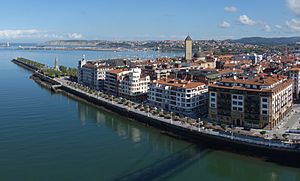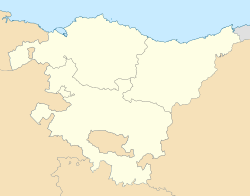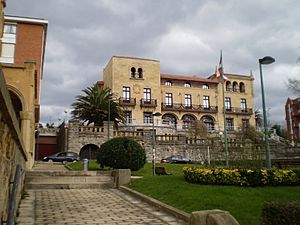Getxo facts for kids
Quick facts for kids
Getxo
|
||
|---|---|---|

Getxo from Vizcaya Bridge with its neighborhood of Las Arenas in the foreground
|
||
|
||
| Motto(s):
Kaltea Dagianak Bizarra Lepoan
("He who makes evil, the beard at his back") |
||
| Country | Spain | |
| Autonomous community | Basque Country | |
| Province | Biscay | |
| Comarca | Greater Bilbao | |
| Judicial district | Getxo | |
| Districts | Aiboa,Algorta, Las Arenas, Neguri, Romo and Getxoko Andra Mari | |
| Founded | 1075 | |
| Area | ||
| • Total | 11.89 km2 (4.59 sq mi) | |
| Elevation | 50 m (160 ft) | |
| Population
(2018)
|
||
| • Total | 78,276 | |
| • Density | 6,583.3/km2 (17,051/sq mi) | |
| Demonym(s) | Getxotarra | |
| Time zone | UTC+1 (CET) | |
| • Summer (DST) | UTC+2 (CEST) | |
| Postal code |
48991 - 48993 - 48990 - 48930
|
|
Getxo (Basque: [getʃo]) is a town in the Biscay province of Spain. It is part of the Basque Country.
Getxo is close to Bilbao and is home to about 75,000 people (as of 2023). It is known as a wealthy residential area. It is also the third largest town in Biscay.
Contents
History of Getxo
Getxo was once a rural area with a large beach. It started as a small fishing village called Algorta. The local council used to meet at the church of Getxoko Andra Mari. This name means Saint Mary of Getxo.
The town's coat of arms shows an oak tree with two cauldrons. Its motto, Kaltea Dagianak Bizarra Lepoan, is a Basque proverb. It means "He who makes evil, the beard at his back." This suggests that people who do bad things often look back, fearing what might happen to them.
In the 1800s, industries grew, and Getxo changed a lot. Some areas became homes for rich families. A new neighborhood called Neguri was built. Its name means "Winter Town" in Basque. The village of Algorta also grew around its church. A new district called Las Arenas (meaning "The Sands") was built on the beach.
Near Las Arenas, a working-class area called Erromo also grew. Later, in the 1900s, more homes were built in the rural parts of Getxoko Andra Mari.
Getxo and the nearby area grew very fast in the late 1900s. In the early 1980s, about 50,000 people lived here. Now, there are over 83,000 residents. Nearby towns like Leioa and Sopelana also saw their populations increase.
Getxo was affected by a period of conflict in the Basque Country. There were several violent events in the town. For example, in October 1978, three civil guards were killed. In May 2008, there was a car bomb attack.
Geography of Getxo
Getxo is located about 14 kilometers (8 miles) north of Bilbao. It is in the province of Biscay, in northern Spain. The town covers an area of about 11.64 square kilometers.
Getxo shares borders with other towns. To the north is Sopelana, and to the east are Berango and Leioa. To the south is Portugalete, and to the west is the Bay of the Cove.
Getxo's Neighborhoods
Getxo has several official neighborhoods. These include Las Arenas, Algorta, Romo, Neguri, and Santa María de Getxo. However, people who live in Getxo often divide them even further:
- Las Arenas: Includes Las Mercedes, Santa Ana, Zugazarte, and Antiguo Golf.
- Neguri: Includes Neguri and San Ignacio.
- Algorta: Includes Algorta center, Alango, María Cristina, Sarrikobaso, Arrigunaga, Villamonte, La Humedad, Aldapas, Fadura, Ereaga, Usategui, Portu Zaharra (the Old Port), and Bidezábal.
- Aiboa
- Santa María de Guecho / Getxoko Andra Mari: Includes Aixerrota, Malakate, Punta Galea, Avenida del Ángel, La Venta, and Azkorri.
- Romo
The very first part of Getxo was called Santa María or Andra Mari. It was a group of country houses around Saint Mary's church.
Las Arenas and Neguri were built in the late 1800s. They were fancy neighborhoods for rich business families. Neguri is known for its grand palaces. Many wealthy people still live there today. The name Neguri comes from Basque words meaning "winter city." It was designed as a place for the rich to live in winter.
Algorta is the largest neighborhood in Getxo by population. It grew a lot in the 1970s. Many middle-class families moved there from other areas. They wanted a more comfortable place to live.
Romo was first built for working-class families. It used to be separated from Las Arenas by train tracks. Now, the Gobelas river separates it on one side. Part of the road that borders Romo is actually the municipal border between Getxo and Leioa.
Santa María de Getxo stayed mostly rural for a long time. It still has old farmhouses and fields. But many new houses and villas were built there in the 1990s.
Historic Monuments in Getxo
Getxo has many interesting old buildings and places to visit.
Andra Mari Church
This church was first built in the 1100s in the Romanesque style. It was where the first people of Getxo gathered. The church you see today was mostly rebuilt in the 1600s in the Baroque style. Inside, there is a sculpture of the Virgin Mary and her son.
Aixerrota Windmill
This is the only old windmill still standing in Getxo. It was built between 1726 and 1727. People built it because there was a big drought, and they needed to grind corn and animal feed. When it was no longer used as a mill, it became a home for many years.
The name Aixerrota comes from Basque words meaning "wind" (Aixe) and "mill" (errota). Today, a company owns it. It has been restored and now has a restaurant and an art gallery.
Prince's Castle or La Galea Fort
This military fort was built in the 1700s. Its job was to protect the ships coming and going from Bilbao. It is in a great spot on a cliff overlooking the bay. The name "Galea" comes from a French word for "cliff."
This fort was also called "Prince's Castle." It is a special example of military building in Biscay. From the cliff, soldiers could watch for enemy ships. The fort was never attacked. After it was no longer used by the military, a lighthouse was built there in 1782. Today, the town owns the fort.
Saint Anne's Chapel (Santa Ana)
This chapel in Las Arenas is a beautiful example of the Neo-Gothic style. A rich businessman named Maximo Aguirre had it built in 1864. It was designed by Modesto de Echániz y Zavalla.
The chapel is in a peaceful, green area. From 1864 to 1876, it was the only church in Las Arenas. Today, it belongs to Maximo Aguirre's family. It is mostly used for weddings now.
Vizcaya Bridge or El Puente Colgante
This famous bridge is in Las Arenas. It is the oldest bridge of its kind in the world. The architect Alberto Palacios y Elissague designed it. It was built in 1893 to connect Getxo and Portugalete across the river.
The bridge was made with iron from local mountains. It is a key symbol of the Industrial Revolution in the area. It is also a main symbol of the region.
Galerias de Punta Begoña
This large stone structure was built in 1919. It was meant to be part of Getxo's defensive wall. It looks very impressive, even though it is quite old and needs repair. Work is being done to restore it.
These galleries and viewing balconies are very special. They follow the shape of the Punta Begoña headland. In the past, a fort stood here to defend the bay.
The galleries were designed by architect Ricardo Bastida in 1918. A famous businessman named Horacio Echevarrieta ordered them. Their main job was to hold back the cliff where his family's mansion stood. The owner also made parts of the galleries into a fun area for relaxing.
They are built with stone and concrete. They have three levels of galleries with terraces and balconies.
Getxo's Administration
Getxo's mayor has always been from the Basque Nationalist Party (EAJ-PNV) since Spain became a democracy in 1978. The main opposition party has been the Partido Popular (PP) since 1991.
In the 2019 local elections, other parties also had representatives on the Town Council. These included EH Bildu, the Socialist Party of Euskadi (PSE-EE), and the Elkarrekin Podemos alliance (EP).
| Political party | Votes | % votes | town councillors |
|---|---|---|---|
| EAJ-PNV | 16 344 | 39,06% | 11 |
| PP | 6 881 | 16,45% | 5 |
| EH Bildu | 6 311 | 15,08% | 4 |
| PSE-EE | 4 420 | 10,56% | 3 |
| UP-EA-IU-EQUO-Berdeak | 3 334 | 7,94% | 2 |
Getxo has five main areas for administrative and election purposes: Algorta, Las Arenas, Romo, Santa María de Getxo, and Neguri.
Transport and Tourism in Getxo
Getxo is easy to reach from Bilbao by using the modern Bilbao metro system. There are 6 metro stations in Getxo's neighborhoods. You can also get to Getxo from Portugalete by using the famous Vizcaya Bridge or by taking a boat across the river.
The Bilbao Airport in Loiu is only about twenty minutes away from Getxo's town center.
Getxo is a popular place for tourists. It has four beaches and is close to Bilbao, a major city. The town has a yacht harbor and a golf course. There are also many sports centers, both public and private.
Getxo's culture department organizes many events. These include international music festivals for jazz, blues, and folk music.
The town has many interesting buildings. These include the Town Hall and several churches. There are also beautiful private homes that belonged to rich industrial families. The Old Harbour area of Algorta is also worth visiting. You can also find parks with great views of the Bilbao Abra bay.
Festivals in Getxo
Getxo celebrates several festivals each year. Many of these are fiestas patronales, which are festivals honoring patron saints.
- Around May 15: Saint Isidore the Laborer, celebrated in Andra Mari.
- From June 20 to 23: Celebrations in Zubilleta.
- June 23: Saint John the Baptist.
- Near July 16: Our Lady of Mount Carmel, celebrated in Neguri Langile.
- July 25: Saint Jacques' day, a public holiday in the Basque Country. There is a paella cooking contest in the fields of Aixerrota.
- From July 25 to 27: Saint Anne, celebrated in Santa Ana.
- Around July 31: Saint Ignatius of Loyola, celebrated in Algorta.
- From August 6 to 10: Celebrations in Romo / Itzubaltzeta.
- From August 12 to 17: Festivals in the Old Port of Algorta.
- Around September 24: Our Lady of Mercy, celebrated in Areeta / Las Arenas.
- Around November 9: Saint Martin of Tours, celebrated in La Humedad, Algorta.
Getxo also has Christmas festivals. Many neighborhoods have parades with Olentzaros (a Basque Christmas character) on Christmas Eve (December 24). There is also a longer Cavalcade of Magi parade through Algorta and Las Arenas on January 5.
Sports in Getxo
Since 1924, Getxo has hosted the Circuito de Getxo. This is an annual bicycle race held in July.
Each year, one of Getxo's rowing clubs organizes a race for traineras (traditional Basque rowing boats). This race is called the Flag of Getxo. Other trainera competitions also take place partly in Getxo's waters.
Getxo has several football clubs. The most famous is the Arenas Club de Getxo football team. They played in the very first national Spanish football league season. They were in the First Division for seven seasons and won the 1919 Copa del Rey cup.
Getxo Rugby Taldea (also known as Getxo Artea) is the local rugby team. They play in the División de Honor, which is a top league.
Getxo also has clubs for many other sports. These include golf, traditional Basque sports, Basque pelota, skating, cycling, sailing, basketball, surfing, fishing, athletics, triathlon, rhythmic gymnastics, handball, futsal, chess, tennis, paddle tennis, horse riding, hockey, and boxing.
Basque Language in Getxo
The Basque language is important in Getxo. According to the city, about 19.9% of people speak Basque well. Another 31.5% can understand it but do not speak it fluently. About 48.56% of citizens do not know enough Basque.
The number of people who can speak Basque has grown. In 1981, only 9% could speak it. By 2001, this increased to 19.9%. However, only about 4.83% of Getxo's population uses Basque regularly. This number has also grown, especially among children and young people.
You can also learn the Basque language in several academies in Getxo.
See also
 In Spanish: Guecho para niños
In Spanish: Guecho para niños
Images for kids
-
Churruca pier
-
Monument to Evaristo Churruca in Las Arenas.












